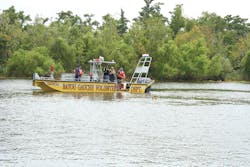The city of New Orleans occupies about 180 square miles of land, 49% of which is below sea level. Basically, the citizens of New Orleans live in a bowl surrounded by water. This fact was hammered home when Hurricanes Katrina and Rita slammed into the city in 2005 and flooded 80% of it. The massive proportions of nature’s assault on the city meant that most of the local first responders who conducted rescues during the first week after the storm did so in their own watercraft.
After the storm, The Leary Firefighters Foundation (http://www.learyfirefighters.org) donated 15 18-foot flat boats with motors and trailers to the New Orleans Fire Department (NOFD). The department also acquired five more flat boats, a 20-foot mud boat and two Carolina Skiff boats, all with motors and trailers, through a Homeland Security grant.
What the department did not acquire was a training program, which had to be built from scratch. The department’s initial objective was to train all personnel to a basic level in the use of boats to rescue citizens trapped by still or slow-moving floodwaters. The department pulled several members from its Special Operations Section to develop this project. Immediately, those members reached out to one of the most practiced and accomplished water search and rescue organizations on the planet, the U.S. Coast Guard (USCG). The Coast Guard directed the firefighters to its Auxiliary branch, a volunteer organization that performs all functions of active-duty members except law enforcement and that has developed an eight-hour basic boating course that would serve the department’s purposes.
Special Operations personnel met with the local USCG Auxiliary with the objective of adapting the basic boating course to rescue purposes. The first decision to be made was how much of the boating course’s content would be used for the rescue training. It was decided the entire course would be used. Despite the many “boat basics” (port is left, starboard is right) that would bore our more experienced boaters, they were necessary for the majority of the department’s personnel. The Auxiliary provided a PowerPoint presentation from which the Special Operations personnel developed a lesson plan that includes Boat Familiarization, Pre-Operation Procedures, Basic Navigation, Boat Operations and Emergencies. At the end of the class, a written test is administered. All personnel passing the written test receive a certificate from the Coast Guard to be used to document and verify the training.
The committee decided to conduct rescue-specific training on a second day using practical application on water, or “underway,” operations. Personnel are tested on launch and safety pre-check procedures and on their ability to safely cast off, slalom around obstacles, back into a slip, traverse under and over obstacles, conduct sharp turns and dock safely. Personnel conduct organized overloading and person-in-the-water drills and are scored on a pass or fail basis using a practical score sheet generated by the committee. Once department members pass the written test and all portions of the underway operations, they receive a certificate developed by the committee giving the date of completion of the course and signed by a member of NOFD Special Operations and the USCG Auxiliary.
The committee felt that no one should participate in operations on the water until their ability to survive on and in the water had been verified, so they conduct an hour’s pool training on day one prior to going into the classroom. Students swim 50 meters in the shallow end of the pool with instructors verifying that they didn’t use the bottom of the pool for any portion of the test. The distance was chosen because it was felt that would be the maximum distance an individual would have to swim in urban flooding conditions to find an object to hang onto until help arrived. Any student who has difficulty or is unable to accomplish the swim is given immediate one-on-one remedial training and if this proves ineffective, the student is dropped from the course. No members will go into the water who cannot save themselves.
Students then float in deeper water and are thrown life vests by instructors. The students are ordered to don the vests to show them how ineffective it is to try to don vests in the water and forcibly bring home the point that vests must be donned on land. Students then practice two different water-entry techniques in deep water and practice two different water-treading techniques.
All of the documents mentioned in this article are available by e-mail at [email protected].






